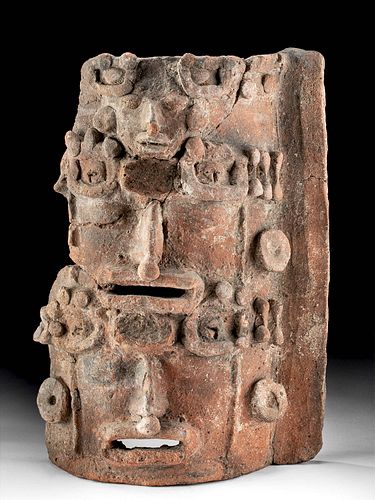Maya Pottery Cache Vessel Fragment w/ 3 Faces
Lot 74c
About Seller
Artemis Fine Arts
686 S Taylor Ave, Ste 106
Louisville, CO 80027
United States
Selling antiquities, ancient and ethnographic art online since 1993, Artemis Gallery specializes in Classical Antiquities (Egyptian, Greek, Roman, Near Eastern), Asian, Pre-Columbian, African / Tribal / Oceanographic art. Our extensive inventory includes pottery, stone, metal, wood, glass and textil...Read more
Estimate:
$2,000 - $3,000
Absentee vs Live bid
Two ways to bid:
- Leave a max absentee bid and the platform will bid on your behalf up to your maximum bid during the live auction.
- Bid live during the auction and your bids will be submitted real-time to the auctioneer.
Bid Increments
| Price | Bid Increment |
|---|---|
| $0 | $25 |
| $300 | $50 |
| $1,000 | $100 |
| $2,000 | $250 |
| $5,000 | $500 |
| $10,000 | $1,000 |
| $20,000 | $2,500 |
| $50,000 | $5,000 |
| $100,000 | $10,000 |
| $200,000 | $20,000 |
About Auction
By Artemis Fine Arts
Oct 22, 2020
Set Reminder
2020-10-22 10:00:00
2020-10-22 10:00:00
America/New_York
Bidsquare
Bidsquare : Ancient & Ethnographic Art Through The Ages
https://www.bidsquare.com/auctions/artemis-gallery/ancient-ethnographic-art-through-the-ages-5850
Ancient art from Egypt, Greece, Italy and the Near East, as well as Asian, Fossils, Pre-Columbian, Native American, African / Tribal / Oceanic, Fine art, and much more! All categories, all price ranges... all legally acquired and guaranteed to be as described or your money back. Artemis Fine Arts info@artemisfinearts.com
Ancient art from Egypt, Greece, Italy and the Near East, as well as Asian, Fossils, Pre-Columbian, Native American, African / Tribal / Oceanic, Fine art, and much more! All categories, all price ranges... all legally acquired and guaranteed to be as described or your money back. Artemis Fine Arts info@artemisfinearts.com
- Lot Description
Pre-Columbian, Belize, Maya culture, Classic Period, ca. 4th to 6th century CE. A hand-built pottery wall fragment from a large cache vessel. The semicircular fragment presents three abstract anthropomorphic faces stacked atop one another, with the top being of a more petite side with slits across the bulging eyes, and the two larger faces with broad mouths, ornamented septums, and grand ear spools. A protruding tab along one wall suggests another, identical tab was present on the opposite side at one time. Faint remains of red-orange pigment accentuate the surfaces and suggest how ornately decorated the full vessel was at one time. Size: 9.75" W x 13.875" H (24.8 cm x 35.2 cm)
Unlike many other ancient civilizations, the Maya did not have cemeteries or necropoli. Instead, they buried human remains with ritual caches of pottery filled with offerings of jade, beads, and other precious items throughout the landscape in which they lived. Scholars posit that these caches were perceived as 'earth offerings' as they have been found buried in and around architectural structures as well as in the fill of buildings, or even set into walls. These caches may have been used as dedications for newly built structures, markers for the end of a building's use, or some type of renewal ceremony relating to the broader concept of Maya cosmology and its relation to the natural agricultural cycle.
Provenance: ex-Hill Auction Gallery, Sunrise, Florida, USA; ex-private A. Wolffson collection, found in 1959 in cave near Belize City, Belize
All items legal to buy/sell under U.S. Statute covering cultural patrimony Code 2600, CHAPTER 14, and are guaranteed to be as described or your money back.
A Certificate of Authenticity will accompany all winning bids.
We ship worldwide and handle all shipping in-house for your convenience.
#159056A fragment of a larger cache vessel. Repaired from several large pieces with small chips and light adhesive residue along break lines. Fading to pigmentation across obverse, with chips and softening to some facial details, and light encrustations. Light remains of pigment and nice earthen deposits. Find information written in white ink on verso.Condition
- Shipping Info
-
All shipping is handled in-house for your convenience. Your invoice from Artemis Gallery will include shipping calculation instructions. If in doubt, please inquire BEFORE bidding for estimated shipping costs for individual items.
-
- Buyer's Premium



 EUR
EUR CAD
CAD AUD
AUD GBP
GBP MXN
MXN HKD
HKD CNY
CNY MYR
MYR SEK
SEK SGD
SGD CHF
CHF THB
THB
















